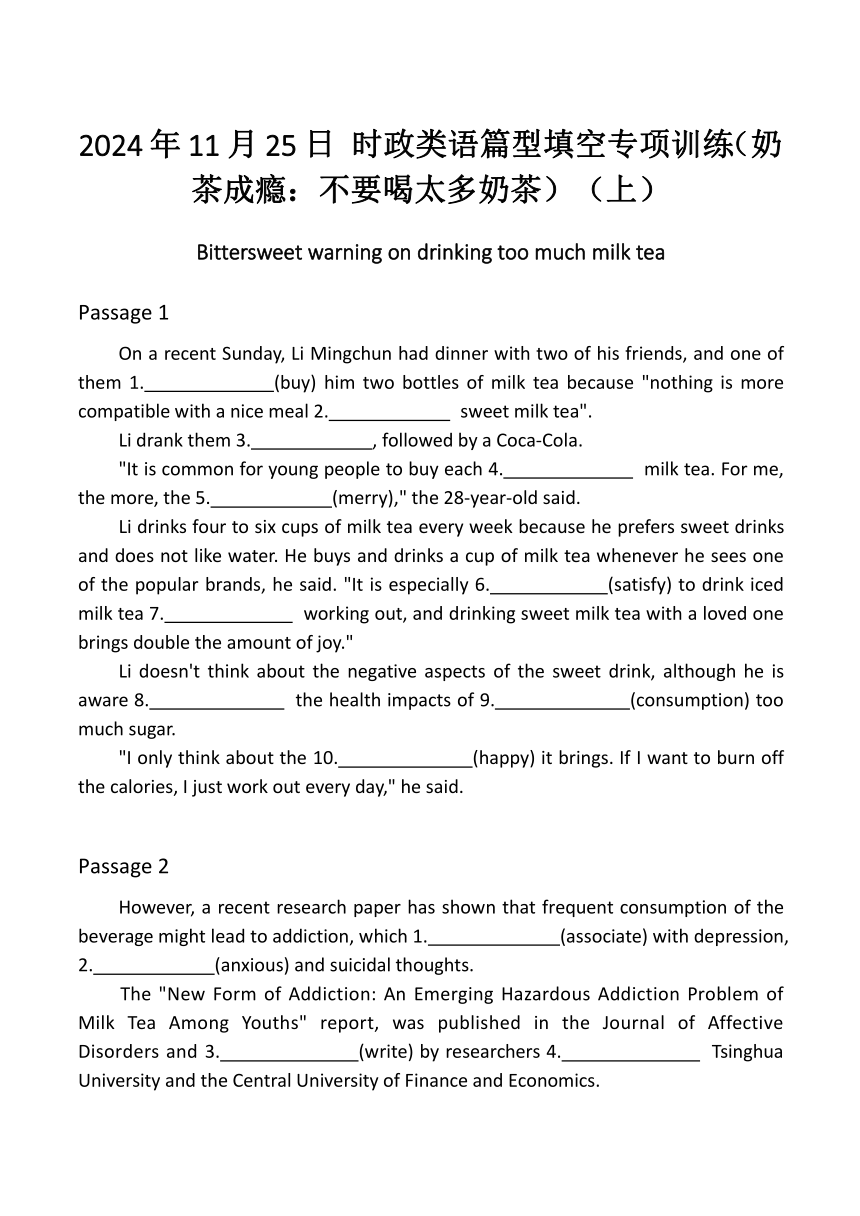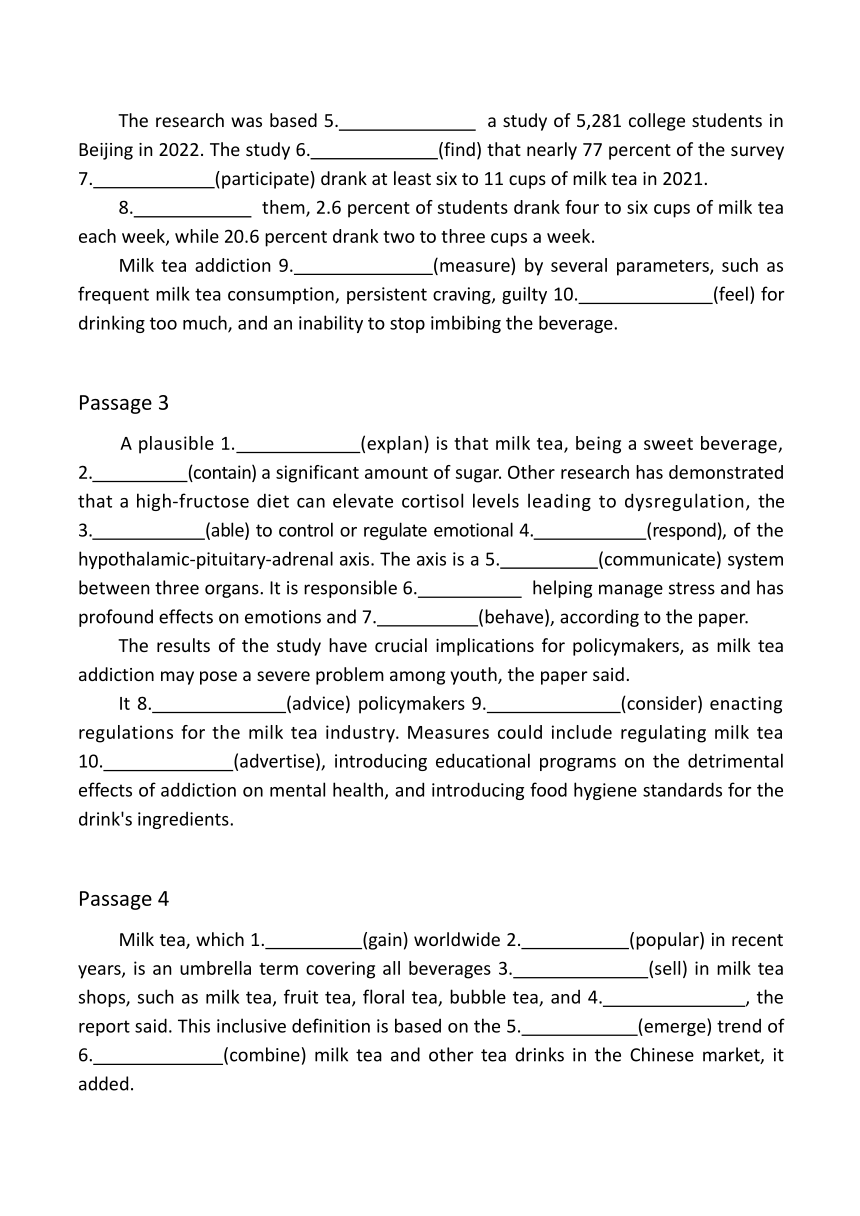2025届高三上学期英语一轮复习专项:2024年11月25日 时政类语篇型填空专项训练(奶茶成瘾:不要喝太多奶茶)(上)(含答案)
文档属性
| 名称 | 2025届高三上学期英语一轮复习专项:2024年11月25日 时政类语篇型填空专项训练(奶茶成瘾:不要喝太多奶茶)(上)(含答案) |  | |
| 格式 | docx | ||
| 文件大小 | 28.1KB | ||
| 资源类型 | 教案 | ||
| 版本资源 | 人教版(2019) | ||
| 科目 | 英语 | ||
| 更新时间 | 2025-01-24 17:04:43 | ||
图片预览


文档简介
2024年11月25日 时政类语篇型填空专项训练(奶茶成瘾:不要喝太多奶茶)(上)
Bittersweet warning on drinking too much milk tea
Passage 1
On a recent Sunday, Li Mingchun had dinner with two of his friends, and one of them 1. (buy) him two bottles of milk tea because "nothing is more compatible with a nice meal 2. sweet milk tea".
Li drank them 3. , followed by a Coca-Cola.
"It is common for young people to buy each 4. milk tea. For me, the more, the 5. (merry)," the 28-year-old said.
Li drinks four to six cups of milk tea every week because he prefers sweet drinks and does not like water. He buys and drinks a cup of milk tea whenever he sees one of the popular brands, he said. "It is especially 6. (satisfy) to drink iced milk tea 7. working out, and drinking sweet milk tea with a loved one brings double the amount of joy."
Li doesn't think about the negative aspects of the sweet drink, although he is aware 8. the health impacts of 9. (consumption) too much sugar.
"I only think about the 10. (happy) it brings. If I want to burn off the calories, I just work out every day," he said.
Passage 2
However, a recent research paper has shown that frequent consumption of the beverage might lead to addiction, which 1. (associate) with depression, 2. (anxious) and suicidal thoughts.
The "New Form of Addiction: An Emerging Hazardous Addiction Problem of Milk Tea Among Youths" report, was published in the Journal of Affective Disorders and 3. (write) by researchers 4. Tsinghua University and the Central University of Finance and Economics.
The research was based 5. a study of 5,281 college students in Beijing in 2022. The study 6. (find) that nearly 77 percent of the survey 7. (participate) drank at least six to 11 cups of milk tea in 2021.
8. them, 2.6 percent of students drank four to six cups of milk tea each week, while 20.6 percent drank two to three cups a week.
Milk tea addiction 9. (measure) by several parameters, such as frequent milk tea consumption, persistent craving, guilty 10. (feel) for drinking too much, and an inability to stop imbibing the beverage.
Passage 3
A plausible 1. (explan) is that milk tea, being a sweet beverage, 2. (contain) a significant amount of sugar. Other research has demonstrated that a high-fructose diet can elevate cortisol levels leading to dysregulation, the 3. (able) to control or regulate emotional 4. (respond), of the hypothalamic-pituitary-adrenal axis. The axis is a 5. (communicate) system between three organs. It is responsible 6. helping manage stress and has profound effects on emotions and 7. (behave), according to the paper.
The results of the study have crucial implications for policymakers, as milk tea addiction may pose a severe problem among youth, the paper said.
It 8. (advice) policymakers 9. (consider) enacting regulations for the milk tea industry. Measures could include regulating milk tea 10. (advertise), introducing educational programs on the detrimental effects of addiction on mental health, and introducing food hygiene standards for the drink's ingredients.
Passage 4
Milk tea, which 1. (gain) worldwide 2. (popular) in recent years, is an umbrella term covering all beverages 3. (sell) in milk tea shops, such as milk tea, fruit tea, floral tea, bubble tea, and 4. , the report said. This inclusive definition is based on the 5. (emerge) trend of 6. (combine) milk tea and other tea drinks in the Chinese market, it added.
According to data by market consultancy iiMedia Research, the market size of China's "new style" tea drinks 7. (reach) 333.4 billion yuan ($46.4 billion) in 2023, and is expected 8. (grow) to 375 billion yuan in 2025.
9. the end of August 2023, there were 515,000 new style tea shops in the country, 10. 36 percent from 2020, the consultancy said.
参考答案
参考答案1
1.bought 2.than 3.both 4.other 5.merrier
6.satisfying 7.after 8.of 9.consuming 10.happiness
参考译文1
最近的一个周日,李明春和两个朋友共进晚餐,其中一个朋友给他买了两瓶奶茶,因为“没有什么比香甜的奶茶更能配得上一顿美餐了”。
李把两杯都喝了,接着又喝了一杯可口可乐。
“年轻人相互购买奶茶是很常见的。对我来说,人越多越开心。”
李每周喝四到六杯奶茶,因为他喜欢甜饮料,不喜欢水。
他说,每当他看到一个受欢迎的品牌,他就会买一杯奶茶喝。“运动后喝冰奶茶尤其令人满足,和爱人一起喝甜奶茶带来的快乐是双倍的。”
李并没有考虑到甜饮料的负面影响,尽管他意识到摄入过多的糖对健康的影响。
“我只考虑它带来的快乐。如果我想消耗卡路里,我就每天锻炼,”他说。
参考答案2
1.is associated 2.anxiety 3.written 4.from 5.on
6.found 7.participants 8.Among 9.was measured 10.feelings
参考译文2
然而,最近的一份研究报告显示,频繁饮用咖啡可能会导致上瘾,这与抑郁、焦虑和自杀念头有关。
这份名为《新形式的成瘾:青少年中出现的有害的奶茶成瘾问题》的报告发表在《情感障碍杂志》上,由清华大学和中央财经大学的研究人员撰写。
该研究基于2022年对北京5281名大学生的调查。研究发现,近77%的调查参与者在2021年至少喝了6到11杯奶茶。其中,2.6%的学生每周喝4到6杯奶茶,20.6%的学生每周喝2到3杯奶茶。
通过几个参数来衡量奶茶成瘾,比如经常喝奶茶,持续的渴望,喝得太多的负罪感,以及无法停止喝这种饮料。
参考答案3
1.explanation 2.contains 3.ability 4.responses 5.communication
6.for 7.behaviors 8.advised 9.to consider 10.advertisements
参考译文3
一个合理的解释是,奶茶作为一种甜饮料,含有大量的糖。其他研究表明,高果糖饮食会提高皮质醇水平,导致下丘脑-垂体-肾上腺轴控制或调节情绪反应的能力失调。中轴线是三个器官之间的通讯系统。根据该论文,它负责帮助管理压力,并对情绪和行为产生深远的影响。
该研究的结果对政策制定者具有至关重要的意义,因为奶茶成瘾可能会给年轻人带来严重的问题。
它建议政策制定者考虑为奶茶行业制定法规。措施可能包括规范奶茶广告,引入关于上瘾对心理健康有害影响的教育项目,以及引入饮料成分的食品卫生标准。
参考答案4
1.has gained 2.popularity 3.sold 4.others 5.emerging
6.combining 7.reached 8.to grow 9.By 10.up
参考译文4
报道称,近年来,奶茶在全球范围内广受欢迎,它是一个总称,涵盖了奶茶店出售的所有饮料,如奶茶、水果茶、花茶、珍珠奶茶等。它补充说,这一包容性定义是基于中国市场将奶茶和其他茶饮料结合起来的新兴趋势。
根据市场咨询公司艾媒研究的数据,2023年,中国“新型”茶饮料的市场规模达到3334亿元人民币(464亿美元),预计到2025年将增长到3750亿元人民币。
该咨询公司称,截至2023年8月底,全国共有51.5万家新式茶店,比2020年增长了36%。
Bittersweet warning on drinking too much milk tea
Passage 1
On a recent Sunday, Li Mingchun had dinner with two of his friends, and one of them 1. (buy) him two bottles of milk tea because "nothing is more compatible with a nice meal 2. sweet milk tea".
Li drank them 3. , followed by a Coca-Cola.
"It is common for young people to buy each 4. milk tea. For me, the more, the 5. (merry)," the 28-year-old said.
Li drinks four to six cups of milk tea every week because he prefers sweet drinks and does not like water. He buys and drinks a cup of milk tea whenever he sees one of the popular brands, he said. "It is especially 6. (satisfy) to drink iced milk tea 7. working out, and drinking sweet milk tea with a loved one brings double the amount of joy."
Li doesn't think about the negative aspects of the sweet drink, although he is aware 8. the health impacts of 9. (consumption) too much sugar.
"I only think about the 10. (happy) it brings. If I want to burn off the calories, I just work out every day," he said.
Passage 2
However, a recent research paper has shown that frequent consumption of the beverage might lead to addiction, which 1. (associate) with depression, 2. (anxious) and suicidal thoughts.
The "New Form of Addiction: An Emerging Hazardous Addiction Problem of Milk Tea Among Youths" report, was published in the Journal of Affective Disorders and 3. (write) by researchers 4. Tsinghua University and the Central University of Finance and Economics.
The research was based 5. a study of 5,281 college students in Beijing in 2022. The study 6. (find) that nearly 77 percent of the survey 7. (participate) drank at least six to 11 cups of milk tea in 2021.
8. them, 2.6 percent of students drank four to six cups of milk tea each week, while 20.6 percent drank two to three cups a week.
Milk tea addiction 9. (measure) by several parameters, such as frequent milk tea consumption, persistent craving, guilty 10. (feel) for drinking too much, and an inability to stop imbibing the beverage.
Passage 3
A plausible 1. (explan) is that milk tea, being a sweet beverage, 2. (contain) a significant amount of sugar. Other research has demonstrated that a high-fructose diet can elevate cortisol levels leading to dysregulation, the 3. (able) to control or regulate emotional 4. (respond), of the hypothalamic-pituitary-adrenal axis. The axis is a 5. (communicate) system between three organs. It is responsible 6. helping manage stress and has profound effects on emotions and 7. (behave), according to the paper.
The results of the study have crucial implications for policymakers, as milk tea addiction may pose a severe problem among youth, the paper said.
It 8. (advice) policymakers 9. (consider) enacting regulations for the milk tea industry. Measures could include regulating milk tea 10. (advertise), introducing educational programs on the detrimental effects of addiction on mental health, and introducing food hygiene standards for the drink's ingredients.
Passage 4
Milk tea, which 1. (gain) worldwide 2. (popular) in recent years, is an umbrella term covering all beverages 3. (sell) in milk tea shops, such as milk tea, fruit tea, floral tea, bubble tea, and 4. , the report said. This inclusive definition is based on the 5. (emerge) trend of 6. (combine) milk tea and other tea drinks in the Chinese market, it added.
According to data by market consultancy iiMedia Research, the market size of China's "new style" tea drinks 7. (reach) 333.4 billion yuan ($46.4 billion) in 2023, and is expected 8. (grow) to 375 billion yuan in 2025.
9. the end of August 2023, there were 515,000 new style tea shops in the country, 10. 36 percent from 2020, the consultancy said.
参考答案
参考答案1
1.bought 2.than 3.both 4.other 5.merrier
6.satisfying 7.after 8.of 9.consuming 10.happiness
参考译文1
最近的一个周日,李明春和两个朋友共进晚餐,其中一个朋友给他买了两瓶奶茶,因为“没有什么比香甜的奶茶更能配得上一顿美餐了”。
李把两杯都喝了,接着又喝了一杯可口可乐。
“年轻人相互购买奶茶是很常见的。对我来说,人越多越开心。”
李每周喝四到六杯奶茶,因为他喜欢甜饮料,不喜欢水。
他说,每当他看到一个受欢迎的品牌,他就会买一杯奶茶喝。“运动后喝冰奶茶尤其令人满足,和爱人一起喝甜奶茶带来的快乐是双倍的。”
李并没有考虑到甜饮料的负面影响,尽管他意识到摄入过多的糖对健康的影响。
“我只考虑它带来的快乐。如果我想消耗卡路里,我就每天锻炼,”他说。
参考答案2
1.is associated 2.anxiety 3.written 4.from 5.on
6.found 7.participants 8.Among 9.was measured 10.feelings
参考译文2
然而,最近的一份研究报告显示,频繁饮用咖啡可能会导致上瘾,这与抑郁、焦虑和自杀念头有关。
这份名为《新形式的成瘾:青少年中出现的有害的奶茶成瘾问题》的报告发表在《情感障碍杂志》上,由清华大学和中央财经大学的研究人员撰写。
该研究基于2022年对北京5281名大学生的调查。研究发现,近77%的调查参与者在2021年至少喝了6到11杯奶茶。其中,2.6%的学生每周喝4到6杯奶茶,20.6%的学生每周喝2到3杯奶茶。
通过几个参数来衡量奶茶成瘾,比如经常喝奶茶,持续的渴望,喝得太多的负罪感,以及无法停止喝这种饮料。
参考答案3
1.explanation 2.contains 3.ability 4.responses 5.communication
6.for 7.behaviors 8.advised 9.to consider 10.advertisements
参考译文3
一个合理的解释是,奶茶作为一种甜饮料,含有大量的糖。其他研究表明,高果糖饮食会提高皮质醇水平,导致下丘脑-垂体-肾上腺轴控制或调节情绪反应的能力失调。中轴线是三个器官之间的通讯系统。根据该论文,它负责帮助管理压力,并对情绪和行为产生深远的影响。
该研究的结果对政策制定者具有至关重要的意义,因为奶茶成瘾可能会给年轻人带来严重的问题。
它建议政策制定者考虑为奶茶行业制定法规。措施可能包括规范奶茶广告,引入关于上瘾对心理健康有害影响的教育项目,以及引入饮料成分的食品卫生标准。
参考答案4
1.has gained 2.popularity 3.sold 4.others 5.emerging
6.combining 7.reached 8.to grow 9.By 10.up
参考译文4
报道称,近年来,奶茶在全球范围内广受欢迎,它是一个总称,涵盖了奶茶店出售的所有饮料,如奶茶、水果茶、花茶、珍珠奶茶等。它补充说,这一包容性定义是基于中国市场将奶茶和其他茶饮料结合起来的新兴趋势。
根据市场咨询公司艾媒研究的数据,2023年,中国“新型”茶饮料的市场规模达到3334亿元人民币(464亿美元),预计到2025年将增长到3750亿元人民币。
该咨询公司称,截至2023年8月底,全国共有51.5万家新式茶店,比2020年增长了36%。
